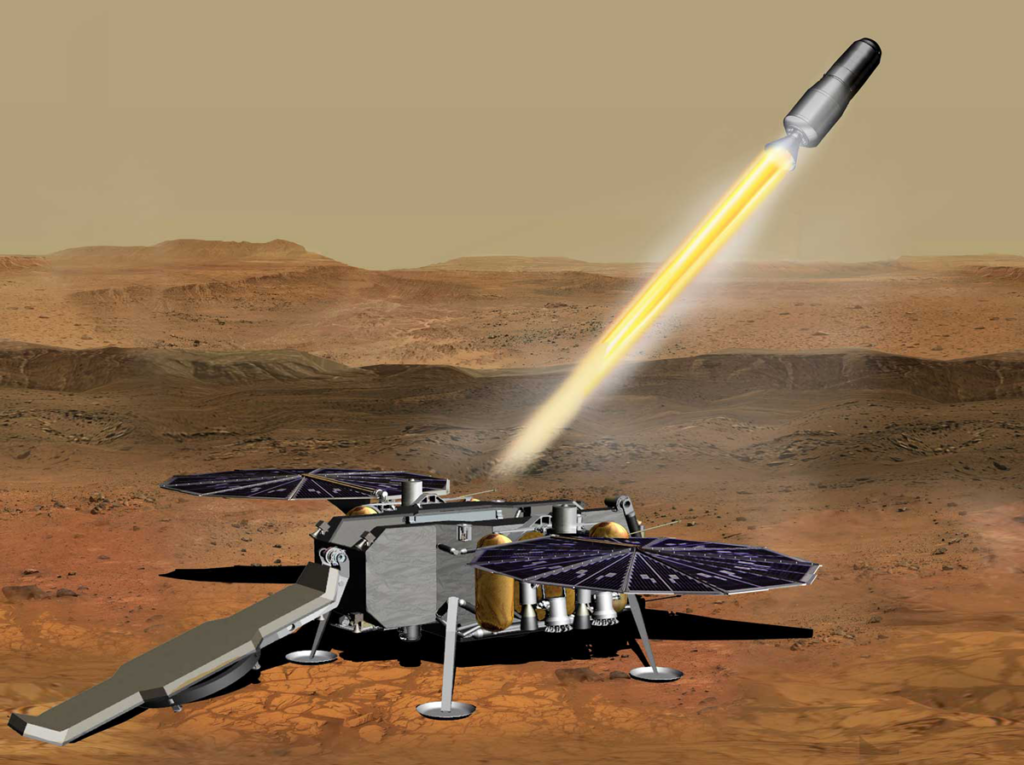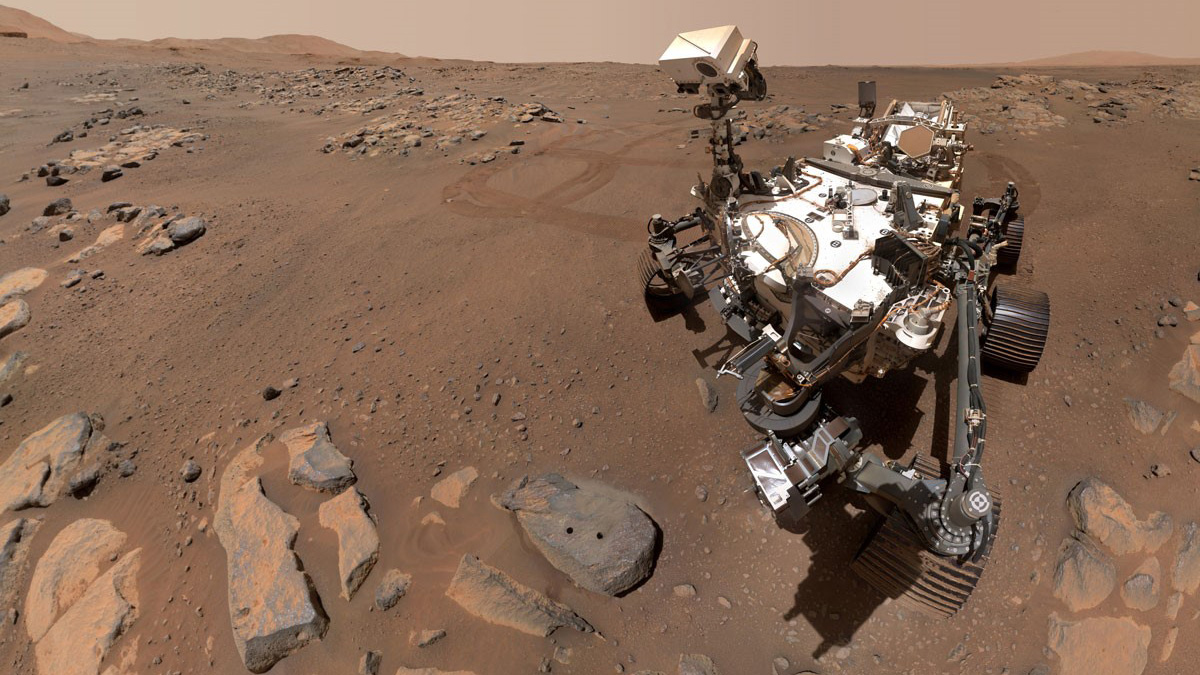Perseverance has barely started its rock hounding on Mars, but scientists are already planning how to handle the rover’s samples when they’re dispatched to Earth. They’re pondering how to keep the samples safe from Earth and Earth safe from the samples while making them accessible to researchers for decades to come.
The potential for life on Mars “is a twofold thing,” said Carl Agee, director of the Institute of Meteoritics at the University of New Mexico and a member of an advisory committee that reviewed requirements for a possible Mars sample facility. “It’s the major science driver for a sample return mission, the major science motivator. But it’s also a major hurdle that has to be overcome. You have to protect Earth from potential microscopic organisms, but you also have to prevent contamination in the samples so you don’t have any confusion if they have evidence of life.”
Perseverance, which has trundled through Jezero crater since February, is the first half of a possible two-step Mars Sample Return (MSR) mission. It will collect almost 40 core samples, each about the size of a stick of chalk, in titanium tubes, which will be sealed tightly. The rover will deposit the samples for collection by a second rover, which is under development by the European Space Agency (ESA). The retrieval rover will load the samples inside a small rocket, which will ferry them to a Mars orbiter for the trip to Earth. (NASA hasn’t given formal approval for the return mission, although it is expected to do so, with launch as early as the late 2020s.)

NASA and ESA still have to work out the details on a receiving and curation laboratory for the samples, including its size, the scientific gear it will contain, its location, and even whether they might want more than one facility. But the advisory committee, MSR Science Planning Group Phase 2 (MSPG2, which will present some of its findings at AGU’s Fall Meeting 2021 on 13 December), and experts within both agencies have outlined the basic challenges and requirements.
Protecting Earth from Mars
The key requirements are to evaluate whether the samples contain any living organisms and, if so, to keep them locked safely away, preventing any possible contagion.
“The chances they will contain extant life are extremely low,” said Andrea Harrington, Mars sample curator at Johnson Space Center. “If we find something, it’s more likely to be extinct. But we’re taking a very careful approach. We’ll protect Earth from the samples.”
Initially, the samples will be stored and handled in a biosafety level 4 facility, which provides the highest level of protection against releasing dangerous agents into the environment. The air pressure will be lower in the facility, ensuring that nothing accidentally flows out. Samples will be stored and evaluated in sterilized cabinets made from special materials and filled with nitrogen or other gases, and planners are considering fully robotic systems for handling the samples.
Once they are proven to be free of Martian bugs, the samples will be moved to less restrictive quarters, where the emphasis will be on protecting them from Earthly contamination. “We want to protect them from humidity, dirt, microbes, fungus, people with grubby fingers—you name it,” said Agee. “They’ll be kept extremely clean and pristine.”
On to the Science
Most of the detailed scientific work will be performed by individual scientists at their own laboratories, so the initial evaluations at the sample return facility will be designed to prevent altering or contaminating the samples in any way.
“The first step will be a basic characterization,” said Kim Tait, senior curator of minerals at the Royal Ontario Museum in Toronto and a member of both MSPG2 and its predecessor, MSPG1. “The material will be weighed, photographed, we’ll have eyes on to determine what kinds of rocks they are. We’ll already have some of that since the rover is scrutinizing the rocks and gathering a lot of field information.”
“The main purpose is to describe the samples to the extent needed so scientists know what to ask for. It’s like a library book. You want to know the title, the author—a few basic things.”
Initial analysis might include extracting some of the Martian atmosphere from the core tubes, conducting X-ray tomography or computed tomography (CT) scans to get an idea of what’s inside the tubes, taking microscopic images of the samples, and other tests. “Technology is evolving quickly, so the instruments we propose today might be completely different in 10 years anyway,” said Tait. “What we really want to get down is the types of information that people will want to extract from the samples.”
“The main purpose is to describe the samples to the extent needed so scientists know what to ask for,” said Agee, who worked at NASA’s lunar samples facility more than 2 decades ago, where he studied concepts for a Mars sample lab to support an earlier mission concept. “It’s like a library book. You want to know the title, the author—a few basic things. The point is, we want to have everything accessible to the broader research community as soon as possible.”
Once the samples are ready, the facility will dole out tiny amounts of them—milligrams or even micrograms at a time. With the amount of material expected to be returned from Perseverance’s excursion, that’s enough for researchers to conduct thousands of studies, Tait said. “There will be more than enough material for my lifetime and the lifetimes of many future observers.”
Planning for the Future
Keeping the samples in good shape for those future scientists is another focus of a storage facility. Samples gathered by Apollo astronauts have been stored at Johnson Space Center for almost half a century, with some opened and studied for the first time in just the past few years. A Mars laboratory must be prepared to keep its samples safe and ready for new scientific investigations for a similar span, with some lying untouched for decades.
“We have to be ready for however long people want to continue doing science,” said Harrington. “We have to be able to get a lot of science out of the samples beyond the first couple of years. That’s the plan.”
Planners are looking at the experience of the Apollo curation team to determine what has worked well and what hasn’t.
“In the Apollo curation facility, a lot of the best practices have been developed since the 1970s, and a lot of them will be adapted for the Mars samples,” said Agee. “A lot of the mistakes have already happened, so we don’t have to go through that again.”
NASA has initiated a study to determine a specific plan for the Mars sample facility, which will take several years to build and test. The agency is considering everything from renting a relatively small facility to building a larger new one, with a ready-to-receive date of 2031 or 2033.
“This is still very much a work in progress,” said Harrington. “We’re still making decisions and identifying benefits and drawbacks of different implementation strategies. But we’re starting to narrow our focus. And I have no doubt we’ll be ready for it.”
—Damond Benningfield, Science Writer
This news article is included in our ENGAGE resource for educators seeking science news for their classroom lessons. Browse all ENGAGE articles, and share with your fellow educators how you integrated the article into an activity in the comments section below.



